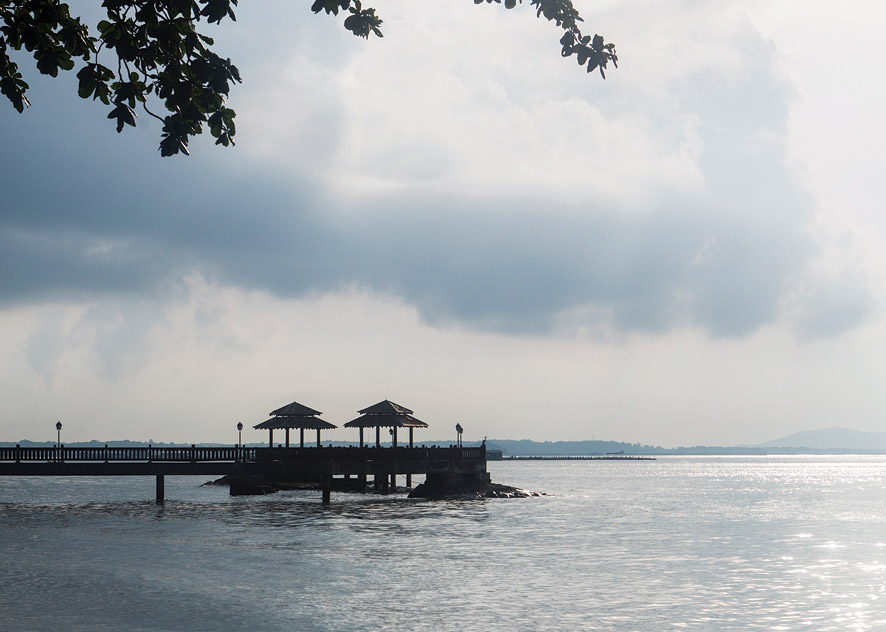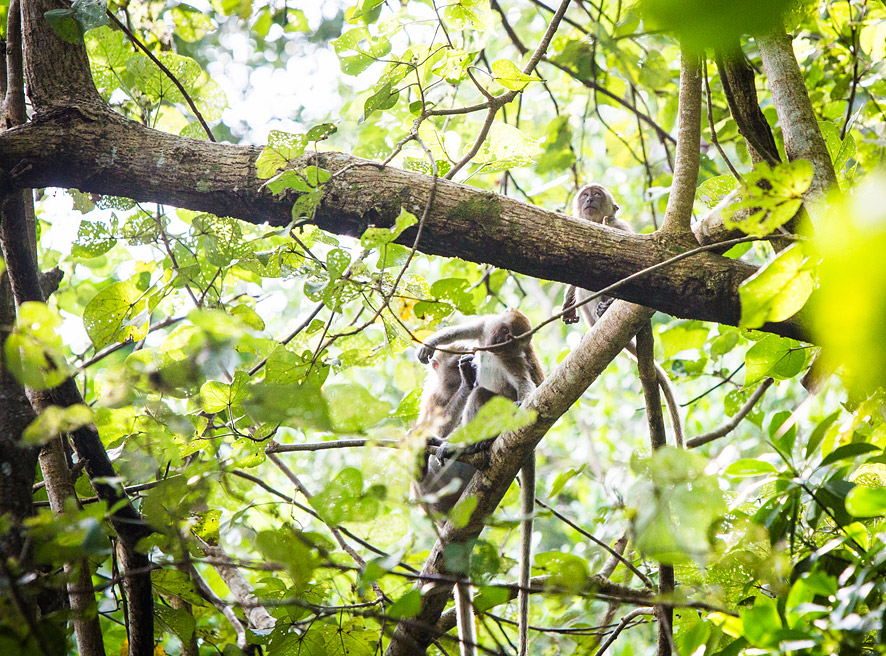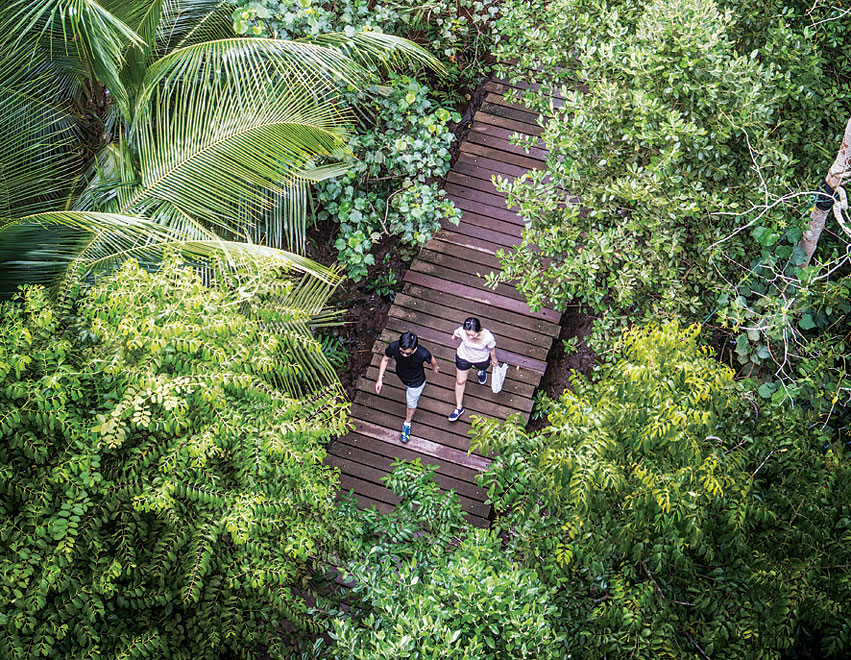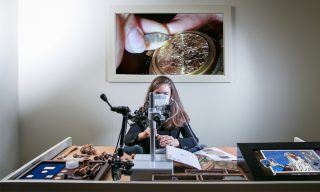Heading east along Jalan Ubin, you’ll pass the two-story house of former island headman Lim Chye Joo, who died in 2006 at the remarkable age of 101; one of his sons lives there still. With a well and a woodstove out back framed by fruit trees and a vegetable patch, the house paints a complete picture of self-sufficient rural living. Photographs fixed to its front wall—of village community groups and Mr. Lim meeting dignitaries—offer a brief snapshot of Ubin’s history since the 1950s.
All the way over on the east coast, the Chek Jawa Wetlands opened to the public in 2007 and showcase seven different habitats, from coral rubble and mangroves to coastal forest, sea-grass lagoons, and (a rarity in reclamation-ravenous Singapore) rocky shore. Some trees at Chek Jawa, like the seashore nutmeg (Knema globularis), are found nowhere else in the country. Along a kilometer-long boardwalk skirting the mangroves, visitors try to spot house crows and fiddler crabs, mud lobsters and wild boar, monitor lizards and sea snakes. You might see a red junglefowl—an ancestor of the domestic chicken— strut along the stony foreshore, or, in a moment of great fortuity, hear the calls of the oriental pied hornbill, the straw-headed bulbul, or the rare mangrove whistler. Twenty meters tall and named for a Malaysian banyan tree, the Jejawi Tower provides a breezy vantage point over the wetlands and beyond to where passenger jets make their final approach to Changi Airport. And the Chek Jawa visitor’s center is as incongruous as any you’ll find in an Asian park—a Tudor-style cottage with the folly of a working fireplace, originally built in the 1930s for Singapore’s chief colonial surveyor.
Ubin’s greatest joy, however, comes with finding solitude and the unexpected, like following a faint bicycle trail through thickets of palm and rubber and bamboo trees that ends up by an old jetty extending into a tidal flat, with nary a soul in sight. Such roads to nowhere are difficult to find across the water in built-up Singapore, yet tantalizingly ubiquitous here.
It’s during such moments of solitude that I find myself envying the handful of people that live here, a feeling validated during conversations with several Ubinites. Ahmad Ben Kassim, a round-faced septuagenarian with sparkling eyes, was born on the island, and his wife, Safia bin Taib, moved here from the mainland after marrying him more than half a century ago. When not selling cold drinks to passersby, they shuffle around their grounds tending to crops and plants. “This is our home. We have nothing in Singapore. Here we have trees, there you have steel buildings.”
Doreen Lim, a slight, energetic woman with a quick smile, is a transplant from Bedok, east Singapore. “I came here with my husband in 1997 because of the economic crisis. I was retrenched and wanted to take a short break.” That short break turned into 16 years. Lim set up a stall selling drinks to the workers building the Celestial Resort (since superseded by the overpriced, unremarkable Celestial Ubin Beach Resort nearer the jetty), and was soon cooking lunch for them. When the resort opened, her husband landed a security job and she set up Pulau Ubin Explorer Services, which takes groups out on nature walks and team-building excursions. “Our aim was that whatever stress they’d have, we’d get rid of it.”
She adds, “Life here is simple and peaceful. I like that. I don’t need stress and noise. The first time I came here I was shocked that there was no water and electricity, but I soon got used to it. When I go back to Singapore now, it’s no fun, too loud, and too hot. Living here, I only miss my parents. Nothing else.”
Chew York Kuan, who runs her family’s third-generation provisions shop, was born on the island, but moved to the mainland after getting married. Still, she makes the bumboat commute every weekday to manage the 80-year-old store, Chew Teck Seng, which stocks candles, ponchos, beach balls, and chilled drinks; it also serves as the local watercooler. On weekends, when the island is overrun with day-trippers, she sleeps on a thin mattress on the shop floor. “If my family could, I’d prefer to live here,” she says. “Life here is more real. As a child, I remember walking around with lanterns and you could go to anyone’s shop if your parents weren’t home, and eat with them, no problem. It was like one big happy family.”
This last year hasn’t been the happiest for Ubin’s residents, however. In January 2013, the government published the Population White Paper: A Sustainable Population for a Dynamic Singapore. It predicted that Singapore’s population, now at 5.3 million, could hit 6.9 million by 2030, and to accommodate the higher numbers, reserve land—Pulau Ubin is officially categorized as “open space and reserve land”—might need to be developed. According to Malone-Lee Lai Choo, director of the Centre of Sustainable Asian Cities at the National University of Singapore, about 60 percent of Singapore’s land area is already built up. Since new land is an uncommon commodity, many fear that virgin territory like Ubin could be caught in the government’s crosshairs.
In March, the Ministry of National Development’s Housing Development Board plastered a letter onto all of the island’s residences. It was titled, “Clearance Scheme: Clearance of Structures Previously Acquired for Development of Adventure Park on Pulau Ubin,” suggesting that Ubin’s days as a modern-day Eden were numbered. But in July, the government reassured parliament that “There is currently no development plan for Pulau Ubin. Our intention is to keep Pulau Ubin in its rustic state for as long as possible, and as an outdoor playground for Singaporeans,” and that the letter was meant as a census and should have been more diligently worded.














